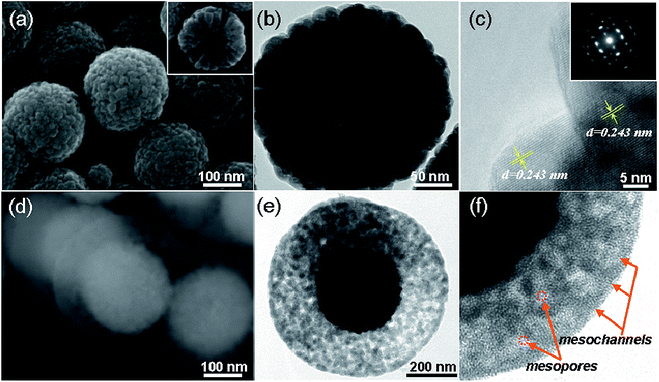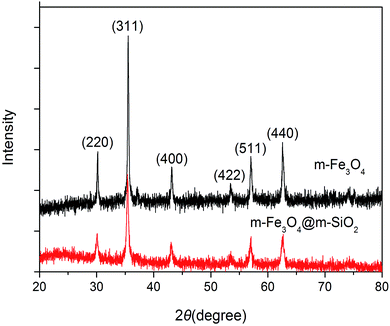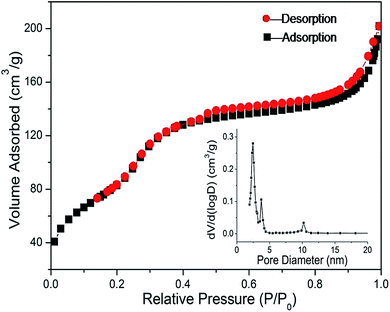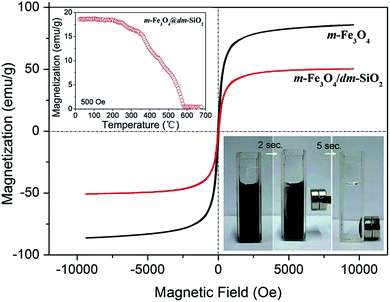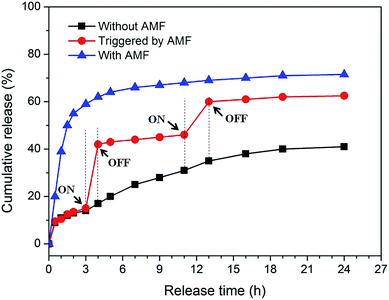 Open Access Article
Open Access ArticleCreative Commons Attribution 3.0 Unported Licence
Multifunctional triple-porous Fe3O4@SiO2 superparamagnetic microspheres for potential hyperthermia and controlled drug release†
Xuegang Lu *a,
Qianru Liub,
Liqun Wanga,
Wenfeng Jianga,
Wenying Zhanga and
Xiaoping Songa
*a,
Qianru Liub,
Liqun Wanga,
Wenfeng Jianga,
Wenying Zhanga and
Xiaoping Songa
aMOE Key Laboratory for Non-equilibrium Synthesis and Modulation of Condensed Matter. School of Science, Xi'an Jiaotong University, Xi'an 710049, China. E-mail: xglu@mail.xjtu.edu.cn; Fax: +86 29 83237910; Tel: +86 29 82663034
bSchool of Physics & Information Technology, Shaanxi Normal University, Xi'an 710119, China
First published on 22nd June 2017
Abstract
Magnetic porous particles with high magnetization and large surface area hold great potential for multimodal therapies. In this work, novel triple-porous Fe3O4@SiO2 microspheres were synthesized by encapsulation of porous Fe3O4 with dual-porous SiO2 shells. This novel triple-porous structure endows the microspheres with features of large surface area (426 m2 g−1) and pore volume; thus they could be used as an efficient drug delivery platform. These microspheres demonstrate superparamagnetic behavior with saturation magnetization of 52 emu g−1. Measurements of AC magnetic-field-induced heating properties showed that the as-prepared microspheres could controllably generate heat to reach the hyperthermia temperature within a short time of exposure to an alternating magnetic field (AMF); hence they could be suitable as a hyperthermia agent for thermal therapy. Using a therapeutic agent 5-fluorouracil (5-Fu) as a model drug, the porous microspheres display high drug loading capacity, and sustained release behavior can be observed under the condition of no AMF actuation, while under the excitation of AMF, controlled drug release behavior can be achieved. Due to its magnetic field induced heating and AMF controlled drug release capabilities, this triple-porous nanomaterial provides an excellent platform for both hyperthermia treatment and drug delivery.
Introduction
Core–shell structured porous nanocomposites with functionalized interior cores and permeable outer shells have recently been recognized as ideal and powerful platforms for wide application in various fields.1–7 Among these, core–shell structured microspheres consisting of a magnetic iron-oxide core and mesoporous silica shell have attracted particular attention owing to their unique magnetic response properties, low cytotoxicity, chemically modifiable surface, high surface areas, well-defined pore structures and multi-functionalities.8–10 The magnetic response of iron-oxide cores enables them to be targeted, imaged and recycled.11–13 Thus, they have been believed to be promising candidates for drug delivery platforms because they can carry drug molecules and can be magnetically guided to the targeted organs or lesion sites inside the body. Furthermore, these targeted magnetic materials at the tumor sites could be remotely heated by applying an alternating magnetic field (AMF), so that they could be used as magnetically controlled hyperthermia or thermoablation agents to generate localized heating for killing of cancer cells. On the other hand, the porous structures of silica materials endow them with high drug-loading capability and sustained release properties due to their high surface area, large pore volume and ease of surface functionalization. They have potential to be used as efficient drug carrier and sustained drug release platform. Therefore, the integration of porous silica with magnetic particles to form core@shell structures presents a good way for simultaneous hyperthermia treatment and drug delivery.10,14–20 Combination of chemotherapy and hyperthermia would greatly improve the therapeutic effect against cancers.In view of biological applications, the ideal magnetic material should possess quick magnetic response for fast separation, suitable surface area to maximize loading target objects and excellent biocompatibility to avoid any cytotoxic effect.21–23 So far, many efforts have been made to achieve magnetic mesoporous silica microspheres.24–26 However, most of these materials either show poor magnetic response, irregular core–shell structures, and single porous structure or possess mesopores that are difficult to access. This limits their performance in biomedical applications. To achieve quick magnetic response and good dispersion stability, superparamagnetic properties with high magnetization are needed. High magnetization enable easy separation or targeting of the particles by external magnetic fields, and superparamagnetism can prevent the particles from aggregating due to strong magnetic interactions in circulation.27 Several methods have been developed to prepare superparamagnetic iron-oxide nanoparticles including thermal decomposition, reverse micelle synthesis, and solvothermal synthesis.28–31 However, most of these superparamagnetic particles show low saturation magnetization owing to their small size (less than 20 nm). An increase in the size can increase the magnetization, unfortunately this may also induce the superparamagnetic–ferromagnetic transition. Therefore, how to achieve magnetic particles with both superparamagnetism and high saturation magnetization is still a challenge.
In addition, to achieve silica shells with desirable porous structure, many methods have been explored in controlling the permeation of silica shells. Various types of templates, such as cetyltrimethylammonium bromide (CTAB), n-octadecyltrimethoxysilane (C18TMS), polyvinylpyrrolidone (PVP) et al. have been employed as porogens in creating mesoscale pores.32–35 Disordered, highly ordered or even rattle-type mesoporous SiO2 shells have been achieved. Unfortunately, these materials commonly possess single or monotonous porous structure so that it is difficult to obtain high surface area, high drug loading capacity and desirable drug release properties. To further achieve highly porous iron-oxide@SiO2 nanocomposites, some new types of porous configurations have been proposed recently. For example, Ken Cham-Fai Leung et al. designed and successfully prepared dual-porous γ-Fe2O3@meso-SiO2 microspheres using a templating method, in which porous γ-Fe2O3 cores were coated by porous SiO2 shells. These dual-porous microspheres, with BET surface area about 222.3 m2 g−1, can be used as a bifunctional agent for both MRI and drug carrier.36 Haijiao Zhang et al. developed a multi-shelled mesoporous silica microsphere by a facile dual-templating method. The BET surface area and total pore volume was calculated to be 237.0 m2 g−1 and 0.40 cm3 g−1, respectively.37 Guang Shao et al. developed a one-step electrostatic self-assembly templated approach to achieve yolk–shell structured Fe3O4@SiO2 nanospheres with very high specific surface area, a huge cavity and ink-bottle type pores.38 Although great efforts have been made in exploring new types of porous structures of iron-oxide@SiO2 nanocomposites, it is still a great challenge to obtain iron-oxide@SiO2 with more sophisticated pore configurations.
Herein, we report a facile synthesis route to obtain novel triple-porous Fe3O4@SiO2 microspheres. First, mesoporous Fe3O4 cores (denoted as m-Fe3O4) are prepared through a modified hydrothermal method. Then, the Fe3O4 cores are coated by SiO2 shells. By controlling the permeation of silica shells through “surfactant-templating and surface-protected etching” strategy, dual-porous SiO2 shells (denoted as dm-SiO2) are formed on the surface of porous Fe3O4 cores. As-made multiple-porous magnetic microspheres possess superparamagnetism and high magnetization. Because there was no intermediate blocking SiO2 layer between porous Fe3O4 cores and dual-porous SiO2 shells, continues and highly accessible mesopores from SiO2 shell to Fe3O4 core can be achieved, which endows the microspheres with high surface area (426 m2 g−1) and large pore volume (0.48 cm3 g−1). The unique triple-porous structure is believed to be favourable for hosting molecules of various sizes and shapes. Drug loading and release test indicated that the microspheres show high drug loading capacity and typical long sustained release properties with 5-fluorouracil (5-FU) as the model drug. Measurements of AC magnetic-field-induced heating properties showed that the obtained microsphere possesses high heating efficiency and is suitable as a hyperthermia agent for thermal therapy. And most interestingly, it is found that the drug release behaviour can be controlled or triggered by an external AC magnetic-field. With excellent biocompatibility and low cytotoxicity characterized in vitro, the obtained triple-porous Fe3O4@SiO2 microspheres can be potentially used in the multiple biomedical therapies.
Experimental
Materials
FeCl3·6H2O, NaAc, NaOH, ethylene glycol (EG), diethylene glycol (DEG), anhydrous ethanol, aqueous ammonia solution (28%), tetraethyl orthosilicate (TEOS, 98%), polyethylene glycol (PEG, Mw = 20![[thin space (1/6-em)]](https://www.rsc.org/images/entities/char_2009.gif) 000), sodium polyacrylate (PAAS, Mw = 10
000), sodium polyacrylate (PAAS, Mw = 10![[thin space (1/6-em)]](https://www.rsc.org/images/entities/char_2009.gif) 000), cetyltrimethylammonium bromide (CTAB), PVP were purchased from Shanghai Chemical Reagents Company (China) and used as received. Fluorinated pyrimidine 5-fluorouracil (5-FU) was purchased from Sigma-Aldrich (China, mainland). Deionized water was used in all experiments. Human blood plasma, human gastric cancer SGC-7901 cells and phosphate buffer saline (PBS) solutions were provided by Xi'an Fourth Military Medical University (China).
000), cetyltrimethylammonium bromide (CTAB), PVP were purchased from Shanghai Chemical Reagents Company (China) and used as received. Fluorinated pyrimidine 5-fluorouracil (5-FU) was purchased from Sigma-Aldrich (China, mainland). Deionized water was used in all experiments. Human blood plasma, human gastric cancer SGC-7901 cells and phosphate buffer saline (PBS) solutions were provided by Xi'an Fourth Military Medical University (China).
Synthesis of mesoporous Fe3O4 microspheres
Mesoporous Fe3O4 microspheres were fabricated according a modified procedure.39–41 Briefly, FeCl3·6H2O (1.35 g), NaAc (3.60 g), PEG (0.5 g), and PAAS (0.2 g) were dissolved in mixture of EG and DEG (40 mL) to form a homogeneous solution with vigorously stirring. This solution was transferred into a Teflon-lined stainless autoclave (50 mL capacity), and sealed heating at 200 °C. After reaction for 12 h, the autoclave was cooled to room temperature naturally. The precipitate was collected by magnetic separation and washed several times under sonication with water and ethanol and then dried under vacuum at 40 °C.Synthesis of triple-porous m-Fe3O4@dm-SiO2 microspheres
Dual-porous SiO2 shells on mesoporous Fe3O4 cores were obtained through a novel “surfactant-templating and surface-protected etching” strategy by controlling the permeation of silica shells. Here, CTAB was used as surfactant template and PVP was as surface protecting agent. Firstly, 0.10 g of as-prepared m-Fe3O4 particles were treated with 0.1 M HCl aqueous solution (50 mL) by ultrasonication. After the treatment for 10 min, the m-Fe3O4 particles were separated and rinsed several times with deionized water, and homogeneously dispersed into the solution of CTAB (0.02 M, 50 mL) by mechanical stirring for 20 min. The mixture was diluted with water (30 mL) and ethanol (60 mL), and homogenized under ultrasonic conditions for 30 min, prior to the addition of an ammonia solution (1.2 mL). And then, 0.5 mL of TEOS was added dropwise for 30 min. The resultant mixture was stirred continuously for another 10 h at room temperature. Subsequently, the solution was stayed still at 8 °C for 1 h and the m-Fe3O4@CTAB/SiO2 microspheres were obtained. Secondly, as-prepared m-Fe3O4@CTAB/SiO2 particles were washed and redispersed in deionized water (30 mL) and were heat-treated in water at 98 °C by mechanical stirring for 2–3 h in the presence of PVP (0.5 g, Mw ∼ 50![[thin space (1/6-em)]](https://www.rsc.org/images/entities/char_2009.gif) 000). The mixture was cooled to room temperature rapidly. In this process, the silica coating slowly becomes porous upon hot-water etching with the cooperative effects of CTAB and PVP. The black m-Fe3O4@dm-SiO2 particles were washed repeatedly with deionized water, dried under vacuum, and stored in a freezer before characterization and usage.
000). The mixture was cooled to room temperature rapidly. In this process, the silica coating slowly becomes porous upon hot-water etching with the cooperative effects of CTAB and PVP. The black m-Fe3O4@dm-SiO2 particles were washed repeatedly with deionized water, dried under vacuum, and stored in a freezer before characterization and usage.
Characterization
The crystal structure and purity of the resulting products were examined by powder X-ray diffraction (XRD) analysis using Cu Kα radiation. Morphologies of the samples were studied using field emission scanning electron microscopy (FE-SEM, JSM-7000F). Transmission electron microscopic (TEM) images, and selected area electron diffraction (SAED) patterns were obtained on a JEOL JEM-2010 microscope. Magnetic properties (M–H curve and M–T curve) of the products were investigated using a Lake Shore vibrating sample magnetometer (VSM) with a maximum applied magnetic field of 10 kOe. The BET surface areas of the samples analyzed by nitrogen adsorption–desorption isotherm measurements were carried out on a Micromeritics ASAP 2020 instrument. The Brunauer–Emmett–Teller (BET) surface area and the pore size distribution plots were calculated by applying the linear part of the BET plot and the Barrett–Joyner–Halenda (BJH) model, respectively.Zeta potentials were measured by using a Malvern Instrument ZetaSizer Nano ZS90 at temperature of 25 °C.
Plasma stability
Blank m-Fe3O4@dm-SiO2 microspheres were incubated with human blood plasma in centrifuge tubes for 24 h under mild shaking and then separated by a magnet. The sample was washed once with water and then re-dispersed in water. The size of the colloidal particles was determined with Dynamic Light Scattering (DLS) with a Malvern Instrument ZetaSizer Nano ZS90.Hyperthermia
To evaluate the in vitro inductive heating property of the m-Fe3O4@dm-SiO2 microspheres, time-dependent calorimetric experiments were conducted by exposing 5 mL of the colloid, held in a clear glass biological test tube, to 55 kHz AC magnetic fields. The temperature of AC magnetic field generator was controlled by cycling cooling water at 25 °C. The coil of the AC magnetic field has 5 loops, and the strength of the magnetic field (H) is 4.5 kA m−1. The m-Fe3O4@dm-SiO2 microspheres were dispersed in physiological saline with the concentration of 5, 7.5, 10 mg mL−1 and treated with ultrasound for 30 min before the measurements. The heat generated by the samples was investigated by measuring the change in temperature of the solution as a function of time using a thermometer.Drug loading and in vitro release from m-Fe3O4@dm-SiO2 microspheres
5-FU was used as a model drug to assess the drug loading and release behaviour of the m-Fe3O4@dm-SiO2 microspheres. The loading of 5-FU was carried out by soaking microspheres in a concentrated 5-FU solution while stirring to ensure the diffusion of drug molecules into the mesopores. Briefly, 300 mg of m-Fe3O4@dm-SiO2 microspheres was dispersed in 60 mL of drug solution containing 60 mg of 5-FU at room temperature. The mixture was then stirred for 24 h at room temperature to allow penetration of 5-FU molecules through porous shell channels and into the porous interiors of m-Fe3O4@dm-SiO2 microspheres. To determine the loading profile of 5-FU, the mixture was magnetically separated and 0.5 mL of the supernatant was extracted from the vial at intervals of 0, 8, 16 and 24 h and analyzed by UV-vis spectroscopy at a wavelength of 266 nm. The 5-FU loading in the microspheres was calculated by subtracting the amount of 5-FU in the supernatant from the amount in the original drug solution.The release profiles of 5-FU from m-Fe3O4@dm-SiO2/5-FU particles were obtained as follows: first, 100 mg 5-FU-loaded microspheres were immersed in 20 mL of phosphate buffer saline (PBS) solutions at pH 7.4 and the mixtures were gently stirred at 37 °C. At predetermined time intervals, the dispersed particles were magnetically separated, and 500 μL of the released supernatant medium was extracted from solution. Meanwhile preheated fresh buffer (500 μL) was added to the original supernatant medium after each sampling. The extracted clear solution without magnetic particles was then diluted to 5 mL and analyzed by UV-vis spectroscopy at a wavelength of 266 nm to determine the concentration of 5-FU released from the microspheres. In addition, in order to investigate the magnetically controlled drug release behaviour of the m-Fe3O4@dm-SiO2/5-FU, an AC magnetic field of 55 kHz (the strength of the magnetic field was 4.5 kA m−1) was applied to the solution in different stages of drug release.
In vitro cytotoxicity tests of the m-Fe3O4@dm-SiO2 microspheres
To evaluate the cytotoxicity of m-Fe3O4@dm-SiO2 microspheres, the human gastric carcinoma cells (SGC-7901) were used for the cell viability test. First, the cells were seeded into a 96 well flat-bottom microassay plate and cultured for 24 h. Then, m-Fe3O4@dm-SiO2 samples with different concentrations (0, 8, 32, 64, 100 and 200 μg mL−1) were added into wells, and were co-cultured with cells for 24 h. Cell viability was quantified by the 3-(4,5-dimethylthiazol-2-yl)-2,5-diphenyltetrazolium bromide (MTT) assay by using tissue culture plate as control sample.Results and discussion
The fabrication and controlled release procedure for the m-Fe3O4@dm-SiO2 microspheres are schematically illustrated in Scheme 1. In the first step, Fe3O4 primary nanocrystals were synthesized through a hydrothermal reaction with the assistance of PEG and PAAS. To reduce the surface energy of nanocrystals, the primary nanoparticles assembled together to form hierarchical Fe3O4 porous microspheres. In the next step, mesoporous silica shells were deposited on the Fe3O4 microspheres by utilizing CTAB as the organic template. Subsequently, PVP was used as the surface protecting agent and adsorbed onto the surfaces of m-Fe3O4@CTAB/SiO2 microspheres. Finally, under the surface protection of PVP, the CTAB template was removed and silica shells were gradually etched in a mild way by hot-water etching to realize the formation of dual-porous SiO2 shells, resulting in triple-porous m-Fe3O4@dm-SiO2 microspheres. When an alternating magnetic field was applied, as-prepared triple-porous microspheres can generate heat for hyperthermia, and the loaded drugs could be simultaneously released by field-controlled manners.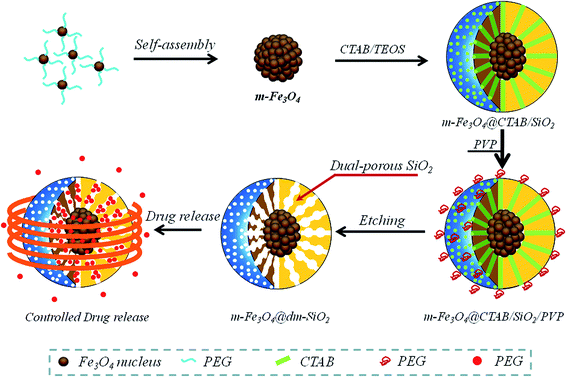 | ||
| Scheme 1 Fabrication strategy and controlled-release procedure for the m-Fe3O4@dm-SiO2 microspheres. | ||
The morphology and structure of as-prepared m-Fe3O4 and m-Fe3O4@dm-SiO2 microspheres were investigated by SEM and TEM analysis, as shown in Fig. 1. The representative SEM image of Fe3O4 microspheres (Fig. 1a) shows that the Fe3O4 particles are monodisperse and uniform on a large scale. The average size of the Fe3O4 particles is ∼260 nm in diameter. The rough surface morphology and loose structure reveal that as-prepared Fe3O4 particles possess hierarchical structure, in which tiny Fe3O4 primary nanocrystals (∼20 nm) assemble together to form Fe3O4 microspheres. Furthermore, from the SEM image (inset in Fig. 1a) and TEM image (Fig. 1b), the Fe3O4 microspheres have porous and hollow interior structure. The SAED pattern recorded on a single isolated microsphere reveals the crystalline nature of the material (inset in Fig. 1c). The crystal lattice fringes seen in HRTEM image (Fig. 1c) indicate that the microspheres are formed by geometrically random but lattice oriented attachment of smaller nanocrystals. The measured d spacing is 0.243 nm, which is in good agreement with the values for (222) planes of a cubic magnetite phase. The formation of mesoporous structure of Fe3O4 microspheres is believed to be due to the steric effect of PEG and PAAS. In this process, PEG and PAAS act as surfactant agent to prevent primary nanocrystals from close contacting and play an important role in the formation of loose and mesoporous structure.
Through a modified Stöber approach by using CTAB as template, core@shell structured m-Fe3O4@CTAB/SiO2 microspheres were obtained (Fig. S1†). With the surface protection of PVP, the CTAB template was extracted and silica shells were selectively etched gradually by hot water so that dual-porous SiO2 shells were achieved. The morphology of the mesoporous magnetic microspheres is clearly shown in SEM (Fig. 1d) and TEM image (Fig. 1e). It is worth noting that as-prepared SiO2 shells possess dual-porous structure, in which perpendicular aligned mesochannels coexist with randomly distributed pores. This is significantly different from traditional mesoporous structures. This dual-porous shell structure can be more clearly observed in the magnified TEM image (Fig. 1f). Moreover, the size of the randomly distributed pores is markedly larger than that of perpendicular aligned mesochannels, which endows the mesoporous structure with great possibilities for holding different drugs with various sizes of molecules. In addition, unlike sandwich structured mesoporous silica microspheres,42,43 as-prepared m-Fe3O4@dm-SiO2 particles have no middle nonporous silica layer between Fe3O4 cores and mesoporous SiO2 shells, and the pores of mesoporous SiO2 directly connect with those of mesoporous Fe3O4 cores. This novel triple-porous structure is favourable for drug molecules to pass through the dual porous SiO2 shells and enter the mesoporous interior of Fe3O4 cores, thus helps to enhance the drug loading capacity and achieve desirable sustainable drug release performance. The formation of this dual-porous structure in SiO2 shells is believed to be due to the cooperative effect of CTAB and PVP. In SiO2 coating process, CTAB templates interact with the silica oligomers via Coulomb forces, and both of them cooperatively assemble on the surface of Fe3O4 microspheres to form ordered mesostructure. The perpendicular aligned orientation of mesochannels may result from the preferable alignment fashion of the rod-shaped silicate/CTAB complexes on the surface of the Fe3O4 microspheres. On the other hand, the presence of PVP on the surface dramatically increases the stability of silica against etching by hot water because of the strong hydrogen bonds formed between its carbonyl groups and the hydroxyls on the silica surface. Prior studies have found that the dissolution of colloidal silica in water proceeds by breaking the Si–O–Si network structures. The etching efficiency is directly related to the degree of condensation of the silica network. Regions with perfect Si–O–Si networks are more resistant to water etching, while those with highly discontinuous networks can be dissolved quickly. This is the reason why randomly distributed pores can be formed after controlled water etching. From Fig. 2, it can be seen that the size of pores can be tuned by changing the etching time. When the etching time was prolonged from 2 h to 4 h, the randomly distributed pores become larger and larger.
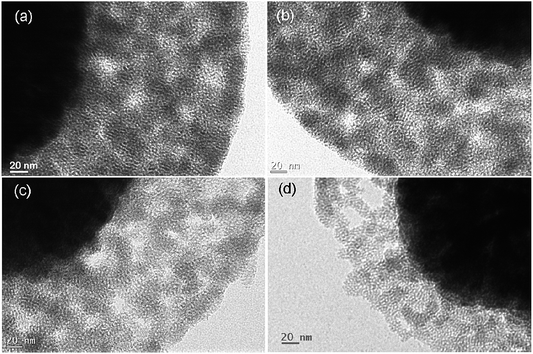 | ||
| Fig. 2 TEM images of dual-porous silica shells obtained at different etching time: (a) 2 h, (b) 2.5 h, (c) 3 h, (d) 4 h. | ||
Fig. 3 shows the XRD patterns of as-prepared m-Fe3O4 and m-Fe3O4@dm-SiO2 microspheres. All of the diffraction peaks can be well indexed to the magnetic cubic inverse spinel Fe3O4 (JCPDS 75-0033). No crystalline SiO2 can be detected in sample of m-Fe3O4@dm-SiO2 microspheres. The average crystal size of the Fe3O4 cores, obtained by calculation of Sherrer's formula, is about 20 nm, which is consistent with the SEM and TEM images (Fig. 1a and b). The XRD results of m-Fe3O4@dm-SiO2 microspheres suggest that Fe3O4 as the cores of m-Fe3O4@dm-SiO2 microspheres are stable during the silica coating and hot-water etching.
To better understand the resulting porous structures, nitrogen adsorption–desorption measurements were carried out. Fig. 4 shows the representative N2 adsorption–desorption isotherms and the corresponding pore size distributions of the m-Fe3O4@dm-SiO2 samples. The N2 adsorption–desorption isotherms exhibit typical type-IV curve, revealing the presence of mesoporous structure. Moreover, it can be clearly seen that three peaks, located at around 2.5 nm, 4 nm and 10.5 nm respectively, appear on the pore size distribution curve (Fig. 4 inset), indicating that as-prepared microspheres possess triple-porous structure. Obviously, the peaks centered at 2.1 nm and 4 nm should be attributed to the perpendicular aligned mesochannels and randomly distributed pores in silica shell respectively and other weaker signal centered at 10.5 nm is corresponded to the porous Fe3O4 core. The BET (Brunauer–Emmett–Teller) surface area and total pore volume of m-Fe3O4@dm-SiO2 microspheres were calculated to be 426 m2 g−1 and 0.48 cm3 g−1, respectively. Because of the large surface area, large pore volume, and novel triple-porous structures, the m-Fe3O4@dm-SiO2 microspheres have potential to be used as efficient drug carriers. Drugs with various sizes of molecules could be absorbed and moved into the internal mesopores.
The typical room temperature magnetization loops of m-Fe3O4 and m-Fe3O4@dm-SiO2 microspheres were depicted in Fig. 5. The results show the saturation magnetization of m-Fe3O4 and m-Fe3O4@dm-SiO2 samples are 81 and 52 emu g−1, respectively. No remanence and coercivity were detected for all of the samples, indicating superparamagnetic nature of particles. The lower value of magnetization for m-Fe3O4@dm-SiO2 microspheres is due to the presence of nonmagnetic SiO2 shell. The inset in Fig. 5 shows the typical magnetization vs. temperature plot of m-Fe3O4@dm-SiO2 microspheres measured in an applied field of 500 Oe. The M–T curve shows that the Curie temperature (TC) of m-Fe3O4@dm-SiO2 is about 580 °C, which is in agreement with that reported for Fe3O4.44 The microspheres show fast movement to the applied magnetic field and redisperse quickly with a slight shake once the magnetic field is removed (insets in Fig. 5), suggesting that the microspheres possess excellent magnetic responsivity and redispersibility. Furthermore, negligible precipitate was observed for the suspension within 24 hours, confirming the stability of the colloidal particles in aqueous suspension. The stability of the aqueous dispersion of the synthesized m-Fe3O4@dm-SiO2 in aqueous medium was also verified from its measured zeta potential values, as seen from Fig. S2 and S3.† The initial zeta potential of m-Fe3O4@dm-SiO2 was −37.4 mV and then stayed almost unchanged (∼−36.6 mV) after 30 days. The surface charge of colloidal particles is not only from the hydroxyl groups adsorbed on the surface, but also from the silanol groups formed by the breaking of the Si–O–Si bond during etching. The negatively charged surface provides the m-Fe3O4@dm-SiO2 colloids with strong interparticle repulsions, which benefits their stability in aqueous solution.
We also examined the buffer stability of the nanosystems, and we found that the nanosystems were still well dispersed in phosphate buffer saline solutions after being stored 24 h. The aggregation and precipitation of the particles were not evident, indicating the nanosystems remained stable. Although the zeta potential was increased to −25.2 mV (Fig. S4†) due to the presence of cations, the remaining negative charge on the surface is still the main reason to ensure that the colloidal particles do not aggregate and precipitate in the buffer solution.
In order to meet the requirements of the in vivo use, the plasma stability of the nanosystems must be concerned. By monitoring the changes of mean hydrodynamic diameter (Dh) of colloidal particles in the plasma, we can determine whether the occurrence of protein adsorption or aggregation, and thus to evaluate its plasma stability. The results showed that the plasma treated nanosystems showed no obvious protein-induced size increase (or aggregation), as shown in Fig. S5,† indicating that the colloidal particles have the plasma stability and are potentially to act as drug carrier in vivo applications.
Fig. 6 represents the time-dependent temperature curves obtained after application of an AMF on m-Fe3O4@dm-SiO2 suspensions. As seen in Fig. 6, after being exposed to the 55 kHz AMF (field strength is 4.5 kA m−1) for 12 min, sufficient energy deposition was achieved, and the temperatures of physiological saline suspensions containing m-Fe3O4@dm-SiO2 microspheres were increased to 41 °C, 48 °C and 56 °C when the colloidal concentrations are 5, 7.5, and 10 mg mL−1, respectively. The heat generation involves several different mechanisms. For superparamagnetic iron-oxide nanoparticles, heat-generation under an AMF from eddy currents and hysteresis loop will be negligible.45 Thus, it is believed that the heat generation are mainly attributed to Brownian relaxation modes (heat due to friction arising from total particle oscillations) and Neel relaxation modes (heat due to rotation of the magnetic moment with each field oscillation).46 A reasonable assumption is that 5–10 mg of magnetic material concentrated in each cm3 of tumor tissue is appropriate for magnetic hyperthermia in human patients.47 From Fig. 6 it can be observed that, for suspensions with concentration of 5–10 mg mL−1, a hyperthermia temperature (41–56 °C) can be quickly achieved under AMF.
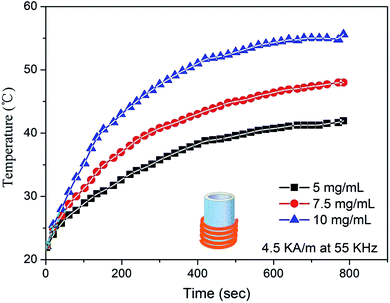 | ||
| Fig. 6 Time-dependent heating curves acquired under AMF (55 kHz, 4.5 kA m−1) for various concentrations of m-Fe3O4@dm-SiO2 suspensions. | ||
To investigate loading and release properties of m-Fe3O4@dm-SiO2 microspheres, we used anti-cancer drug, 5-FU, as a model drug to introduce into m-Fe3O4@dm-SiO2 microspheres. As the size of 5-FU molecules is very small (∼0.5 nm), the pores of m-Fe3O4@dm-SiO2 microspheres (with the minimum size of 2.5 nm) are big enough for holding or transport of drug.48 The drug loading process is believed to relies on the physical adsorption of 5-FU in the mesopores. The loading capacity of 5-FU in the m-Fe3O4@dm-SiO2 microspheres, after 24 h in 2 mg mL−1 5-FU solution, is calculated to be 62 μg mg−1 (as seen in Fig. S6†).
The in vitro release profile of 5-FU from the m-Fe3O4@dm-SiO2 microspheres with and without the use of external AMF actuation are demonstrated in Fig. 7. Same amount of 5-FU loaded m-Fe3O4@dm-SiO2 microspheres were used in PBS solution for all the drug-release experiments. Under the condition of no AMF actuation, it was found that the m-Fe3O4@dm-SiO2/5-FU microspheres have typical sustained release property and about 40% of drug is released from the microspheres after 20 h. A small burst release is observed within the initial 0.5 h, which is indicative of the released drug adsorbed on the surface or in the shallow nanopores. This sustained release property can be attributed to the multiple-mesoporous structure of m-Fe3O4@dm-SiO2 microspheres. Under the excitation of AMF, however, the release of 5-FU is greatly promoted and a big burst release was observed in the initial 2 h of release. The cumulative drug release under AMF exposure was about 1.8 times greater than that without the AMF stimulus. Moreover, it is interesting to realize that, when an external AMF was applied to the drug-loaded microspheres for 1 h and 2 h respectively after 3 h and 11 h of sustained release, a significant increase in the amount of drug release was observed. After then, the release profile restores to a slow profile. In other words, the drug release behaviours of microspheres can be changed from a steady-state, slow profile to a burst profile immediately after a short time exposure to the AMF stimuli. The plausible reason of this AMF actuated burst release is due to the thermal and dynamic energy produced by the AC magnetic field. High frequency magnetic-field can not only cause the oscillation or vibration of m-Fe3O4@dm-SiO2/5-FU microspheres but also generate heat in magnetic microspheres. The vibration of m-Fe3O4@dm-SiO2/5-FU microspheres and increase in temperature accelerate the diffusion of drug molecules from the interior mesopores of m-Fe3O4@dm-SiO2 to the outside solution, thus resulted in the increase of drug release.
The in vitro cytotoxicity tests of m-Fe3O4@dm-SiO2 microspheres with and without 5-FU loading were conducted using human gastric cancer SGC-7901 cells by a MTT assay, as shown in Fig. 8. The SGC-7901 cells were cultured with m-Fe3O4@dm-SiO2 microspheres of varying concentrations for 24 h. The cytotoxicity was expressed by the percentage of cell viability compared to the control group. The result shows that the viability of the cells treated with m-Fe3O4@dm-SiO2 microspheres without drug loading, in the concentration range of 8–200 μg mL−1, remained above 80%, revealing that m-Fe3O4@dm-SiO2 microspheres were of low cytotoxicity. On the contrary, for 5-FU loaded m-Fe3O4@dm-SiO2 microspheres, the cell viability decreased obviously with increasing the concentration drug carriers. The cell viabilities were only 14% when the concentration of the sample was 200 μg mL−1. The results can also be seen from microscopic images of cellular morphological changes (as seen in Fig. S14†).
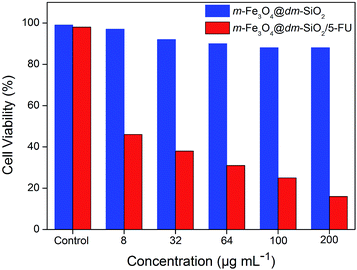 | ||
| Fig. 8 Cell viability of SGC-7901 cells after being cultured at different concentrations of the m-Fe3O4@dm-SiO2 (blue) and m-Fe3O4@dm-SiO2/5-FU (red) for 24 h. | ||
Conclusions
In conclusion, novel triple-porous m-Fe3O4@dm-SiO2 microspheres were prepared via a controlled chemical process. The composite microsphere composes a mesoporous Fe3O4 core and a dual porous SiO2 shell. With the cooperative effect of CTAB and PVP, a complex mesoporous structure, in which perpendicular aligned mesochannels accompanied with randomly distributed mesopores, can be achieved in the SiO2 shell. As-prepared m-Fe3O4@dm-SiO2 microspheres possess superparamagnetism, high magnetization (52 emu g−1), high surface area (426 m2 g−1), large pore volume (0.48 cm3 g−1) and low cytotoxicity. The microspheres exhibit magnetic-field induced heating ability. Moreover, owning to the unique multiple-mesoporous structure, the m-Fe3O4@dm-SiO2 microspheres show a high drug loading efficiency and typical sustained release property. Interestingly, as-prepared m-Fe3O4@dm-SiO2 microspheres display AMF controlled drug release property. The drug release behaviours of microspheres can be changed from a steady-state, slow profile to a burst profile immediately after a short time exposure to the AMF stimuli. Therefore, as-prepared m-Fe3O4@dm-SiO2 microspheres have great potential to be used in drug delivery and magnetic hyperthermia.Acknowledgements
This work was supported by the National Natural Science Foundation (No. 51172178, 51501142) of P R China. The authors would like to acknowledge the support of Tangdu Hospital of The Fourth Military Medical University for offering assistance for this work.Notes and references
- J. P. Yang, D. K. Shen, L. Zhou, W. Li, X. M. Li, C. Yao, R. Wang, A. M. El-Toni, F. Zhang and D. Y. Zhao, Chem. Mater., 2013, 25, 3030–3037 CrossRef CAS.
- Y. Fang, G. F. Zheng, J. P. Yang, H. S. Tang, Y. F. Zhang, B. Kong, Y. Y. Lv, C. J. Xu, A. M. Asiri, J. Zi, F. Zhang and D. Y. Zhao, Angew. Chem., Int. Ed., 2014, 53, 5366–5370 CrossRef CAS PubMed.
- Y. Wang and H. C. Gu, Adv. Mater., 2015, 27, 576–585 CrossRef CAS PubMed.
- K. W. Qiu, Y. Lu, D. Y. Zhang, J. B. Cheng, L. Yan, J. Y. Xu, X. M. Liu, J. K. Kim and Y. S. Luo, Nano Energy, 2015, 11, 687–696 CrossRef CAS.
- M. H. Wang, X. Q. Wang, Q. Yue, Y. Zhang, C. Wang, J. Chen, H. Q. Cai, H. L. Lu, A. A. Elzatahry, D. Y. Zhao and Y. H. Deng, Chem. Mater., 2014, 26, 3316–3321 CrossRef CAS.
- Y. P. Xie, Z. B. Yu, G. Liu, X. L. Ma and H. M. Cheng, Energy Environ. Sci., 2014, 7, 1895–1901 CAS.
- K. P. Yuan, R. C. Che, Q. Cao, Z. K. Sun, Q. Yue and Y. H. Deng, ACS Appl. Mater. Interfaces, 2015, 7, 5312–5319 CAS.
- Y. F. Zhu, T. Ikoma, N. Hanagata and S. Kaskel, Small, 2010, 6, 471–478 CrossRef CAS PubMed.
- E. Yu, I. Galiana, R. Martinez-Manez, P. Stroeve, M. D. Marcos, E. Aznar, F. Sancenon, J. R. Murguia and P. Amoros, Colloids Surf., B, 2015, 135, 652–660 CrossRef CAS PubMed.
- Y. F. Zhu and C. L. Tao, RSC Adv., 2015, 5, 22365–22372 RSC.
- M. E. de Sousa, M. B. F. van Raap, P. C. Rivas, P. M. Zelis, P. Girardin, G. A. Pasquevich, J. L. Alessandrini, D. Muraca and F. H. Sanchez, J. Phys. Chem. C, 2013, 117, 5436–5445 CAS.
- P. Guardia, R. Di Corato, L. Lartigue, C. Wilhelm, A. Espinosa, M. Garcia-Hernandez, F. Gazeau, L. Manna and T. Pellegrino, ACS Nano, 2012, 6, 3080–3091 CrossRef CAS PubMed.
- L. Lartigue, C. Innocenti, T. Kalaivani, A. Awwad, M. D. S. Duque, Y. Guari, J. Larionova, C. Guerin, J. L. G. Montero, V. Barragan-Montero, P. Arosio, A. Lascialfari, D. Gatteschi and C. Sangregorio, J. Am. Chem. Soc., 2011, 133, 10459–10472 CrossRef CAS PubMed.
- B. Sivakumar, R. G. Aswathy, Y. Nagaoka, M. Suzuki, T. Fukuda, Y. Yoshida, T. Maekawa and D. N. Sakthikumar, Langmuir, 2013, 29, 3453–3466 CrossRef CAS PubMed.
- F. Lu, A. Popa, S. W. Zhou, J. J. Zhu and A. C. S. Samia, Chem. Commun., 2013, 49, 11436–11438 RSC.
- B. B. Shen, X. C. Gao, S. Y. Yu, Y. Ma and C. H. Ji, CrystEngComm, 2016, 18, 1133–1138 RSC.
- W. Guo, C. Y. Yang, H. M. Lin and F. Y. Qu, Dalton Trans., 2014, 43, 18056–18065 RSC.
- C. L. Tao and Y. F. Zhu, Dalton Trans., 2014, 43, 15482–15490 RSC.
- X. Yu and Y. F. Zhu, Sci. Technol. Adv. Mater., 2016, 17, 229–238 CrossRef PubMed.
- C. S. S. R. Kumar and F. Mohammad, Adv. Drug Delivery Rev., 2011, 63, 789–808 CrossRef CAS PubMed.
- A.-H. Lu, E. L. Salabas and F. Schueth, Angew. Chem., Int. Ed., 2007, 46, 1222–1244 CrossRef CAS PubMed.
- Y.-W. Jun, J.-W. Seo and A. Cheon, Acc. Chem. Res., 2008, 41, 179–189 CrossRef CAS PubMed.
- J. Gao, H. Gu and B. Xu, Acc. Chem. Res., 2009, 42, 1097–1107 CrossRef CAS PubMed.
- J. Kim, J. E. Lee, J. Lee, J. H. Yu, B. C. Kim, K. An, Y. Hwang, C. H. Shin, J. G. Park and T. Hyeon, J. Am. Chem. Soc., 2006, 128, 688–689 CrossRef CAS PubMed.
- S. Giri, B. G. Trewyn, M. P. Stellmaker and V. S. Y. Lin, Angew. Chem., Int. Ed., 2005, 44, 5038–5044 CrossRef CAS PubMed.
- S. Huang, Y. Fan, Z. Cheng, D. Kong, P. Yang, Z. Quan, C. Zhang and J. Lin, J. Phys. Chem. C, 2009, 113, 1775–1784 CAS.
- Y. W. Jun, Y. M. Huh, J. S. Choi, J. H. Lee, H. T. Song, S. Kim, S. Yoon, K. S. Kim, J. S. Shin, J. S. Suh and J. Cheon, J. Am. Chem. Soc., 2005, 127, 5732–5733 CrossRef CAS PubMed.
- N. Bao, L. Shen, Y. Wang, P. Padhan and A. Gupta, J. Am. Chem. Soc., 2007, 129, 12374–12375 CrossRef CAS PubMed.
- C. Liu, B. S. Zou, A. J. Rondinone and J. Zhang, J. Am. Chem. Soc., 2000, 122, 6263–6267 CrossRef CAS.
- C. Liu and Z. J. Zhang, Chem. Mater., 2001, 13, 2092–2096 CrossRef CAS.
- N. Pinna, S. Grancharov, P. Beato, P. Bonville, M. Antonietti and M. Niederberger, Chem. Mater., 2005, 17, 3044–3049 CrossRef CAS.
- J. Liu, S. Z. Qiao, Q. H. Hu and G. Q. Lu, Small, 2011, 7, 425–443 CrossRef CAS PubMed.
- Y. Zhu, T. Ikoma, N. Hanagata and S. Kaskel, Small, 2010, 6, 471–478 CrossRef CAS PubMed.
- Q. Zhang, T. Zhang, J. Ge and Y. Yin, Nano Lett., 2008, 8, 2867–2871 CrossRef CAS PubMed.
- J. Ge, Q. Zhang, T. Zhang and Y. Yin, Angew. Chem., Int. Ed., 2008, 47, 8924–8928 CrossRef CAS PubMed.
- S.-h. Xuan, S.-F. Lee, J. T.-F. Lau, X. Zhu, Y.-X. J. Wang, F. Wang, J. M. Y. Lai, K. W. Y. Sham, P.-C. Lo, J. C. Yu, C. H. K. Cheng and K. C.-F. Leung, ACS Appl. Mater. Interfaces, 2012, 4, 2033–2040 CAS.
- L. Wu, H. Zhang, M. Wu, Y. Zhong, X. Liu and Z. Jiao, Microporous Mesoporous Mater., 2016, 228, 318–328 CrossRef CAS.
- F. Liu, J. Wang, Q. Cao, H. Deng, G. Shao, D. Y. B. Deng and W. Zhou, Chem. Commun., 2015, 51, 2357–2360 RSC.
- S. Liu, R. Xing, F. Lu, R. K. Rana and J.-J. Zhu, J. Phys. Chem. C, 2009, 113, 21042–21047 CAS.
- H. Deng, X. L. Li, Q. Peng, X. Wang, J. P. Chen and Y. D. Li, Angew. Chem., Int. Ed., 2005, 44, 2782–2785 CrossRef CAS PubMed.
- B. Luo, X.-J. Song, F. Zhang, A. Xia, W.-L. Yang, J.-H. Hu and C.-C. Wang, Langmuir, 2010, 26, 1674–1679 CrossRef CAS PubMed.
- Y. Deng, D. Qi, C. Deng, X. Zhang and D. Zhao, J. Am. Chem. Soc., 2008, 130, 28–29 CrossRef CAS PubMed.
- W. R. Zhao, J. L. Gu, L. X. Zhang, H. R. Chen and J. L. Shi, J. Am. Chem. Soc., 2005, 127, 8916–8917 CrossRef CAS PubMed.
- J. Wang, W. Wu, F. Zhao and G.-m. Zhao, Appl. Phys. Lett., 2011, 98, 083107 CrossRef.
- R. Ghosh, L. Pradhan, Y. P. Devi, S. S. Meena, R. Tewari, A. Kumar, S. Sharma, N. S. Gajbhiye, R. K. Vatsa, B. N. Pandey and R. S. Ningthoujam, J. Mater. Chem., 2011, 21, 13388–13398 RSC.
- S. Mornet, S. Vasseur, F. Grasset and E. Duguet, J. Mater. Chem., 2004, 14, 2161–2175 RSC.
- Q. A. Pankhurst, J. Connolly, S. K. Jones and J. Dobson, J. Phys. D: Appl. Phys., 2003, 36, R167–R181 CrossRef CAS.
- G. L. Borosky and A. B. Pierini, Org. Biomol. Chem., 2005, 3, 649–653 CAS.
Footnote |
| † Electronic supplementary information (ESI) available. See DOI: 10.1039/c7ra00899f |
| This journal is © The Royal Society of Chemistry 2017 |

